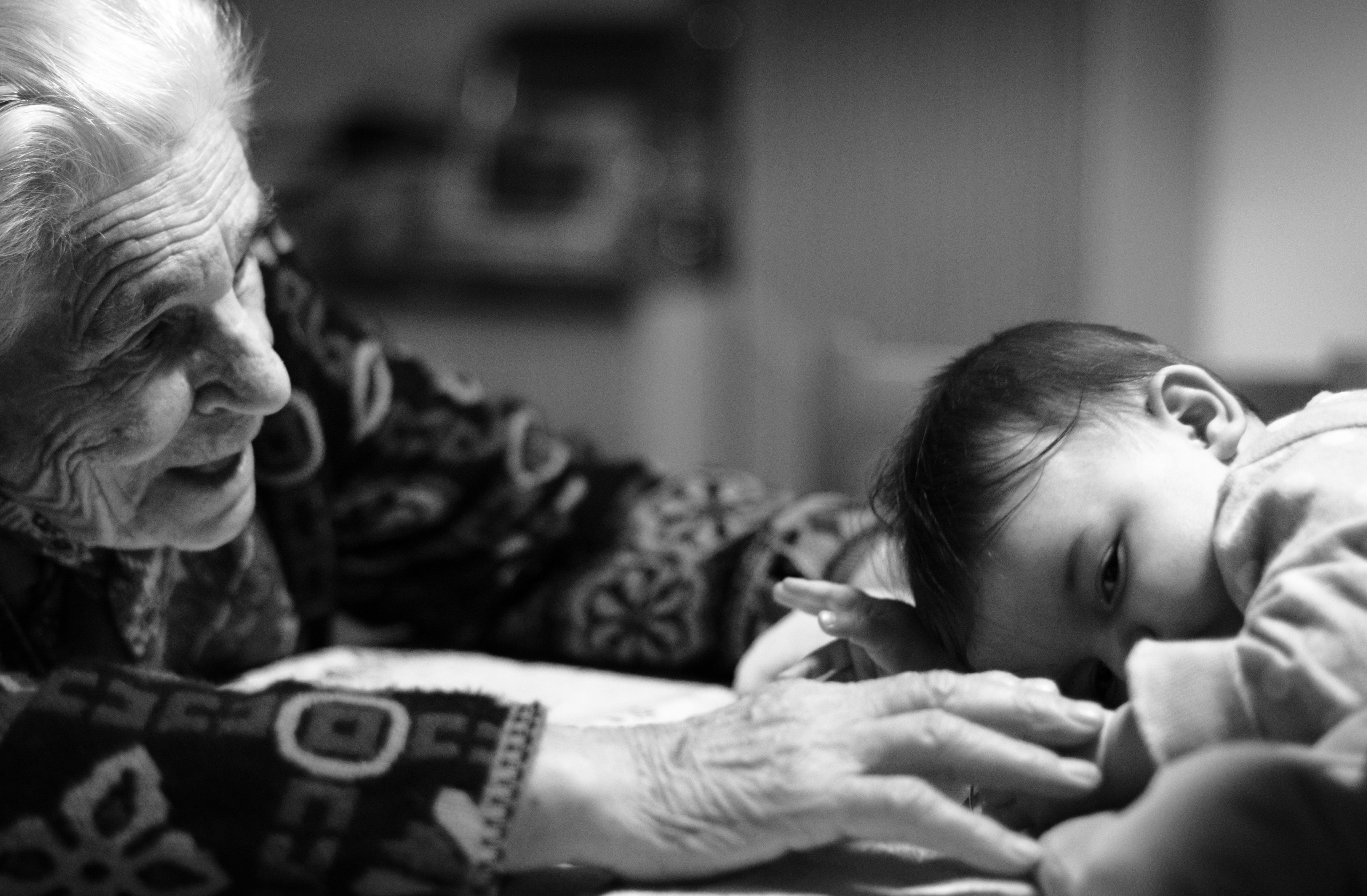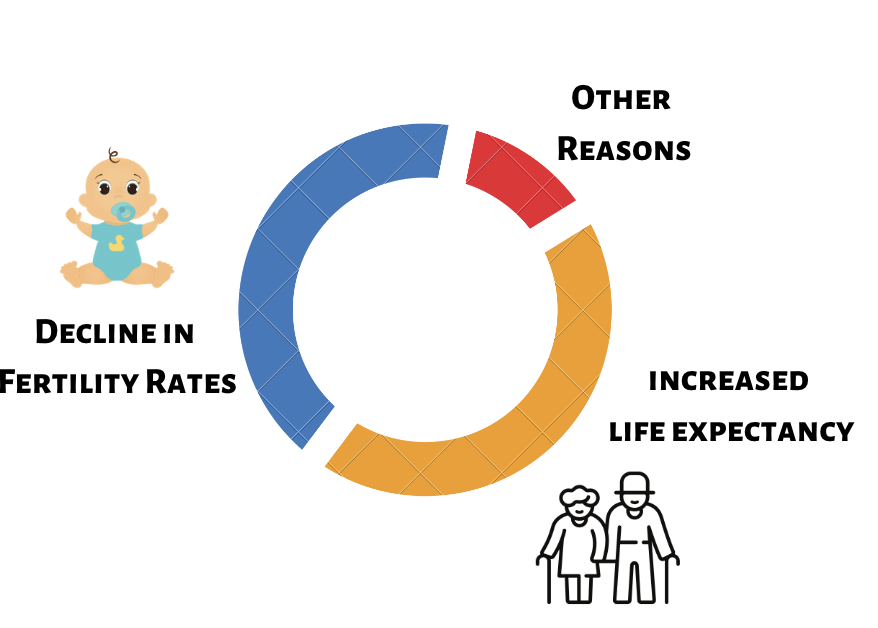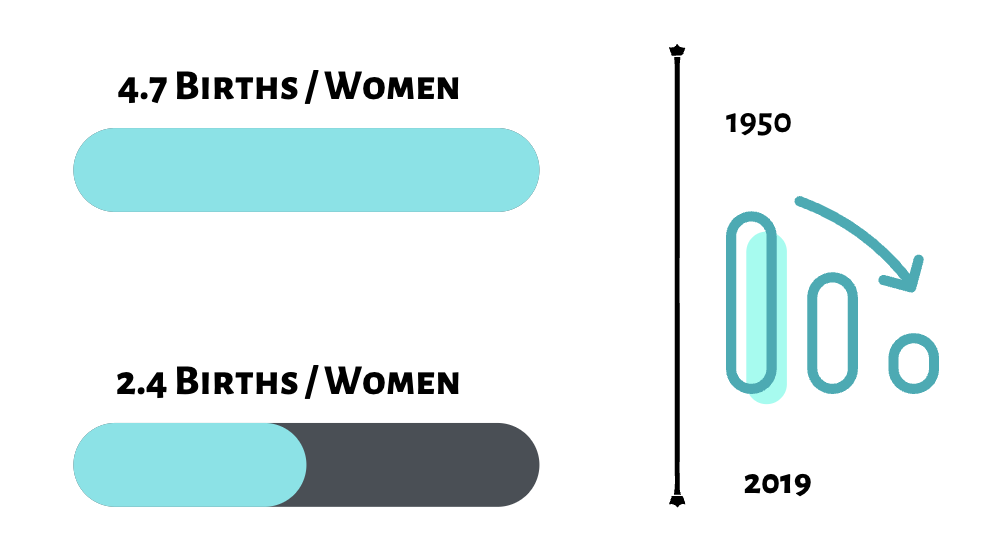Population Aging: Facts, Causes, Solutions

Aging
The world’s population is aging. Virtually every country in the world is experiencing growth in the number and proportion of older persons in their population.
Population Aging is one of the most significant global issues of the twenty-first century. Behind the aging situation, lots of social realities need our attention. For the last 70 years, fertility rates have decreased by 50% worldwide. Behind the low fertility rates, the rising cost of housing, the increasing cost of raising a child, and unstable career development after giving birth to a baby are people's concerns nowadays.
I want to analyze the social realities behind the aging world and provide call-to-actions to policy makers according to analysis results.
The potential takeaways of this project will be:
a. How serious the population aging condition is nowadays and How serious it will be in the future.
b. Which region have relatively more serious population aging problems? What are the demographic characteristics?
c. What’s the main reason behind the population aging and what actions can be done to address the issue?
Part1:
How serious the population aging condition is?

At the end of 2019
1 in 11
People is
65+
At the end of 2050
1 in 6
People is expected to be
65+
Part2:
Which regions have serious aging problems?
Let's look at Top 50 Countries with the largest percentage of old adults (65+)

Demographic characteristics of population aging in the world
39 out of those 50 countries are European countries
Part3:
Reasons behind Population Aging


The aging of the world’s populations is the result of the continued decline in fertility rates and increased life expectancy
Average Fertility Rate in the World

For the last 70 years, fertility rates have decreased by 50% worldwide.
This chart shows the fertility rates of some countries/regions from 1950 to 2020
Click the start button or drag the slider to play around with the visualization
Are countries with low fertility rate facing serious aging problems?
Let's compare countries with lowest and highest fertility rate to figure out the answer

Top 10 countries/regions with highest fertility rate:
Angola; Burkina Faso; Gambia; Nigeria; Nigeria; Chad; Mali; Congo; Somali; Niger
Top 10 countries/regions with lowest fertility rate:
San Mario; Bosnia and Herzegovina; Spain; Ukraine; Macau China; Singapore; Malta; Hong Kong China; South Korea
Most countries with serious population aging problems are also facing the issue of low fertility rates.
Increasing Fertility Rate might be a way to address the issue of aging

Part 4:
Reasons for "Why people don't want to have kids?"
Reference: New York Times - Consult Survey of 1858 men and women about why aren’t having children https://www.nytimes.com/2018/07/05/upshot/americans-are-having-fewer-babies-they-told-us-why.html

Reasons can be summarized into 3 parts:
1. Work/Career development concerns
2. Income/Cost of raising kids
3. Limited leisure time
Career development and leisure time are more related to personal lifestyle instead of social reality
So, for policy makers, cost of raising kids could be one factor to consider and take actions
Cost of raising a child born in 2015 was $233,610. That assumes the child was born to a middle-income, married couple. When adjusted for inflation, the number jumps to $290,014 in 2022 dollars, based on the most recent data from the Bureau of Labor Statistics.

Photo by Alexander Mils on Unsplash

Photo by Alexander Mils on Unsplash

Photo by Alexander Mils on Unsplash
Part 5:
Call-to-Actions

For Policy Makers:
If your region is facing low fertility rate issue,
You might take actions to provide financial support to people with kids in the following perspectives.

Policy Suggestions after conducting the analysis

Housing allowance for families with children
Housing allowance is support for families with children who need help to pay rent or monthly fees for their housing

Photo by Ella Olsson on Unsplash
Photo by Ella Olsson on Unsplash
Free Meal Plan
Provide free or low-cost baby food for "new" parents; Conduct school lunch plan & dinner plan to reduce the food cost for families with children

Photo by Kimberly Farmer on Unsplash
Photo by Kimberly Farmer on Unsplash
Child Care Helps Boost Fertility
Reduce the child care cost of families by providing financial assistance to child care agencies; Free education
Main Takeaways:
1. The world is aging. At the end of 2019, 1 in every 11 people are older than 65, and at the end 2050, 1 in every 6 people are expected to be over 65
2. European countries are facing the most serious aging problems. Among top 50 countries with highest percentage of old adults, 39 countries are European countries.
3. Decreasing fertility rate is one of the main reasons for population aging. For the last 70 years, fertility rates have decreased with 50% worldwide. People are less willing to give birth to a baby nowadays
4. Reasons for "Why people don't want to have kids" can be summarized into 3 parts: career development concerns, financial pressure and less leisure time
5. Cost of raising a kid could be one factor that policy makers need to consider and take actions.
6. Housing, Food, child care & Education are 3 domains that people spend most money in raising a child. Policies such as housing allowance for families with children, free meal plans and less expensive child care & free education could be considered according to different conditions in different regions.
Thanks
By Jingyi Ran
Carnegie Mellon University-Heinz College
Master Student - Business Intelligence and Data Analytics
Contact: jingyiran1@gmail.com
LinkedIn: https://www.linkedin.com/in/jingyiran/

